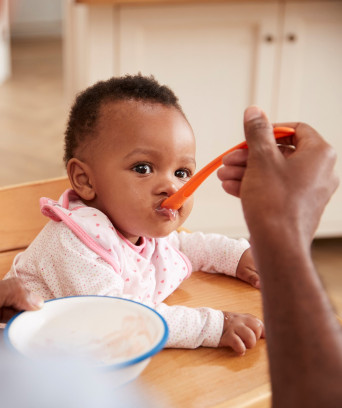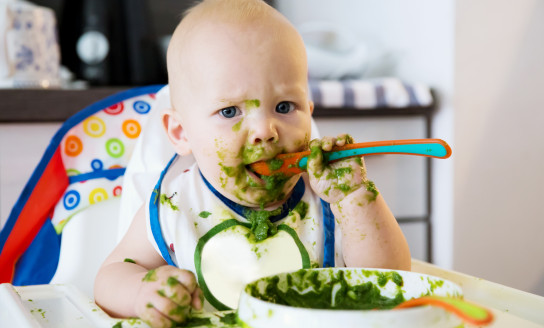Feeding between three and six months
Milk (breast or formula) provides your baby with all the nutrition they need to grow and develop in the first six months.
At around three months of age, your baby might start making more saliva and putting their fists or toys in their mouth, or experience a growth spurt and want to feed more often. These are part of normal development rather than signs that they’re ready for solid food.
Solid food shouldn’t be introduced too early because babies aren’t physically or developmentally ready for it.
Some of the reasons are:
- your baby may feel full and not drink enough milk to grow well
- they can’t coordinate their swallowing to cope with solid food
- their kidneys and digestion aren’t well-enough developed to cope with solid foods
- they may be more likely to get eczema, asthma, food allergies, respiratory infections.
Feeding between six and 12 months
For the first six months or so, babies use iron stored in their bodies from when they were in the womb. They also get some iron from breastmilk and/or infant formula. But as they grow, a baby’s iron stores decrease, and by around six months old, they can’t get all the iron their bodies need from breastmilk or formula alone. That’s why it’s important to start introducing solids when your baby shows interest in solid foods, normally when they’re around six months old.
Like the Ministry of Health, we recommend you continue breast- or bottle-feeding your baby - in addition to feeding them solids - until they’re one year or older.
If you’re breastfeeding, by this time your breasts may feel softer, or not feel so full. This is normal, because by now your breasts and milk supply have settled and become more efficient. It doesn’t mean your supply is reduced. You can be confident your baby’s getting enough milk if:
- they’re sucking and swallowing well when on the breast
- feeding regularly
- having plenty of wet nappies with pale-coloured wee
- growing well.
By six months old, your baby may get distracted by voices and noise while feeding, and might regularly come off the breast, or spit out the bottle, to look around. This is totally normal.
If your baby was born prematurely, they may not be ready for solid food at around six months. Your baby’s paediatrician or Plunket nurse can help you work out when to start offering your baby solid food, and will give you the information you need.
Signs your baby is ready for solid food
Your baby may be ready for solid food if they:
- seem hungry after breast or formula feeds
- can hold their head up well, and can sit upright when supported
- are interested in watching you eat - they reach out, open their mouth when you’re eating, and put their hands and toys in their mouth
- make chewing movements
- easily open their mouth when you touch their lip with a spoon or bring food to their mouth, and their tongue doesn’t push the food out
- move food to the back of their mouth and swallow.
If your baby's hungry, they might:
- get excited when they see you getting food ready
- lean towards you while sitting in the highchair
- open their mouth as you're about to feed them.
Signs your baby isn't interested include:
- turning their head away
- shutting their mouth when you offer food
- losing interest or getting distracted
- pushing the spoon away.
If your baby is nearing seven months and hasn’t started solids, you might like to get some advice from your Plunket nurse or GP.
Your baby’s food preferences
Every baby is different, and it’s fun getting to know what sort of food your baby likes. Some babies will devour solid foods as soon as they’re given them, while others prefer to have just breast milk or formula for longer. Some babies eat everything offered, and others have clear likes and dislikes.
Don’t worry too much about your baby’s food preferences. Keep offering a range of nutritious foods so they can learn to enjoy a variety of food tastes and textures.
When to introduce your baby’s first solid foods
Choose a time when both of you are relaxed, like around lunchtime or early afternoon.
When babies are really hungry, they just want the breastmilk or formula they know will satisfy their hunger, so start by breast or bottle feeding your baby. They’ll still have room to try new foods after they’ve had a feed of breastmilk or formula.
Stage One solids (around six months)
Drinks
Breastmilk or infant formula is still the most important food. Offer your baby breastmilk or formula before solid foods.
Between six and 12 months, breastmilk, infant formula or water are the only liquids your little one needs.
Food texture
Make a very smooth and runny mixture using breastmilk, water or infant formula.
Solid foods to try
- Iron-fortified infant cereal or baby rice, mixed as directed, or pureed plain cooked rice.
- Cooked and pureed fruit: apple, pawpaw, apricot, peach, mango, pear, plum (with no seeds, skins or pips).
- Uncooked mashed banana, avocado.
- Cooked and pureed vegetables without skins, seeds or pips, like kumara, potato, carrot, taro, pumpkin, kamokamo, marrow, cassava, manioke(a), parsnip or yam.
- Cooked and pureed meat like beef, lamb, pork, chicken or fish. Your baby now needs extra iron to grow well. Lamb’s liver is a good source of iron, but it’s best only to offer liver once a week.
- Cooked and pureed vegetarian alternatives like hummus, baked beans, lentils, soaked and cooked dried beans and peas.
- Pre-packaged baby foods in cans, jars and packets suitable for your baby’s age.
Tips
- Offer one or two teaspoons of slightly warm solid foods.
- Offer a variety of purées with different tastes, including naturally sweet, savoury and bitter flavours.
- From around six months of age, babies can eat increasingly thick puréed, mashed and soft foods. Soft foods are those that can be easily squashed between your thumb and forefinger or on the roof of your mouth with your tongue.
- If your baby refuses a food, offer another food instead, but try the food they refused again in a few days. It can take up to ten tastes before your baby may like a new food.
- Gradually increase how much and how often you give solid food. Let your baby’s appetite guide you.
- Gradually increase the thickness and how lumpy the food is.
- Your baby shouldn’t have salt, sugar or butter added to the food.
- Do not offer coffee, tea or alcohol.

Stage Two solids (from seven to eight months)
Drinks
Breastmilk or formula is still the most important food. Offer milk before solid food. Your baby may enjoy drinking water.
Food texture
Thick puree, small soft lumps, or mashed.
Try these foods
Once your baby is eating a good variety of the foods from stage one, try:
- mashed fruit, cooked to soften if necessary before mashing
- mashed, cooked vegetables, offering a variety of different coloured veges. Be sure to remove stalks and stringy bits from leafy green vegetables like puha, spinach, and bok choy
- dairy products like cheese, yoghurt, cottage cheese and custard
- toast (white or fine wholemeal), and rusks
- cooked and mashed pasta and noodles
- tofu, tempeh
- cooked and mashed egg.
Tips
- Try mixing foods with a range of tastes. Mixing less popular foods in with ones your baby really likes may encourage your wee one to accept a wider variety of food.
- Move towards three meals a day.
Stage Three solids (from eight to nine months)
Drinks
Your baby can have solid foods before their breast or formula feeds. It’s great for your baby to have water during the day as well.
Water helps keep:
- babies hydrated
- poo soft (avoiding constipation), and
- teeth and gums nice and healthy.
Food texture
Your baby may now be interested in lots of different foods and textures. Try minced, mashed, grated, and finely chopped foods.
Try adding in:
- fruits – add raw fruit as finger food, like oranges, kiwifruit, pineapple, and berry fruit
- vegetables, including salad veges
- meat, shellfish, kai moana
- cereals like porridge, wheat biscuits (iron fortified), or infant muesli
- peanut butter (smooth).
Wait until your baby’s one year old before offering cow’s milk.
Avoid small, hard and round foods like popcorn, nuts, grapes and berries because they can make your baby choke. Stay with your baby when they’re eating and encourage them to sit down to eat to avoid choking.
Tips
Your baby might enjoy foods they can hold (finger foods).
- Try pieces of soft ripe fruit, cooked vegetable pieces, grated cheese, toast, and small pieces of soft meat.
Wattie's Feeding Guides
Wattie’s and Plunket have worked together to create a series of guides to feeding your child, from their very first solids through to the toddler stage:
- The Wattie’s Guide to Baby Feeding helps you and your baby through the exciting adventure of starting solids, from food examples and textures for different age stages through to helpful feeding tips.
- The Wattie’s Finger Food Ideas from 9 months provides soft textured finger food examples which are cut into shapes that are easy for baby to pick up with little hands and bring to their mouth. The reverse Lunchbox & Snack Ideas guide provides food suggestions for little ones from 12 months onwards.
- The Wattie’s Feeding Toddlers guides provide nutritious meal and snack ideas, along with practical tips for creating positive mealtime experiences with your toddler to help foster a healthy relationship with food.
Wattie's Baby Feeding Guide (PDF)
Wattie's Finger Food Ideas (PDF)
Wattie's Feeding Toddlers Guide (PDF)
